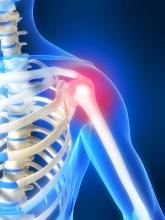TORONTO – More than half of patients in a random sample of individuals seeking treatment for opioid dependence started their journey to addiction with a legitimate medical need for painkillers, according to Dr. Christopher Chiodo.
With the rising morbidity, mortality, and costs associated with opioid dependence, it’s time for physicians to take a closer look at their prescribing habits, said Dr. Chiodo, an orthopedic surgeon at the Brigham and Women’s Faulkner Hospital, Boston.
“You guys are on the back end, taking care of these poor individuals,” Dr. Chiodo told a room full of addiction specialists. “I’m on the front end. I’m the one giving out the prescriptions to patients who are becoming addicted.”
The journey to dependence
In an effort to better understand the role physicians play in the origins of patients’ addiction, Dr. Chiodo and his colleagues at the Brigham and Women’s hospital studied 50 consecutive patients (64% male; mean age, 40 years) being treated for opioid addiction at the hospital’s outpatient center.
Based on an anonymous written survey, the investigators found that 58% of patients received their first opioids from a doctor’s prescription, an additional 28% got the drugs from family and friends, and 14% got them from dealers or other sources.
“There are a lot of patients, for whom we are starting this process. … I’m certainly not going to use the word ‘responsible’ for it, but we’re starting the process,” Dr. Chiodo said at the annual meeting of the American Psychiatric Association.
Orthopedic surgeons weren’t actually the biggest prescribers: 36% of patients reported getting the prescription from a primary care doctor, 7% from a dentist, 7% from an orthopedic surgeon, 14% from general surgeons, and the remaining 36% from other clinicians or from multiple physicians (for example, through doctor shopping).
Perhaps of most concern, at the time the patients reported first considering themselves addicted to opioids, 45% were still getting their drugs from doctors.
The pressures to overprescribe
Many doctors overprescribe just to avoid being called in the middle of the night by a patient in pain. “It’s the low road,” he said.
Other pressures that increase prescribing include patient expectations, increasing surgical volume, and the lack of a longitudinal relationship with patients who are often being treated for acute problems.
“Typical orthopedic office encounters involve patients in pain, quick visits, and we don’t have a longitudinal relationship with these patients – we don’t know who they are, what their personal values are, or their coping or anxiety scores,” Dr. Chiodo said.
Perhaps one of the strongest issues in overprescribing is the desire to avoid complaints, he said.
“You’re doing everything you can to avoid having to confront the patients, so you take the easier road and give them a prescription, and hope they give you a better review in the hospital and on the Internet,” said Dr. Chiodo.
Recent studies have estimated the total annual cost in the United States of opioid abuse to be between $18 billion and $72 billion per year. As well, the United States consumes 80% of the global opioid supply and 99% of global hydrocodone. Studies have shown that patients are more likely to complain about doctors who don’t give them pain medications.
Have the talk
Just prescribing fewer opioids isn’t the only answer, said Dr. Chiodo. What is needed is more dialogue with patients about their pain expectations and their need for opioids.
“I give them 2 weeks [after surgery], and maybe one more prescription to carry them through the third week, but when you get that call, you need to tell your patient that it’s OK to be having some pain,” Dr. Chiodo said. “Half of the time, that’s enough for them; they sigh and say they don’t want the prescription for another week.”
Sometime what is needed – and this is a harder talk to have, said Dr. Chiodo – is an honest suggestion to patients that they are at risk for addiction. “You’re prescribing something very powerful for pain that is affecting their life, and I think we need to talk to our patients more.”
During the Q&A period, Dr. Stephen Frye, a psychiatrist from Las Vegas, suggested that much of this musculoskeletal pain can be better managed with medicinal marijuana.
“Let me assure you that marijuana, which is medically now allowed in 24 states, is really valuable medicine, remarkably safe, you cannot die from it, you cannot OD from it. … This is excellent medication for these problems,” Dr. Frye said.
Dr. Chiodo reported no relevant financial disclosures.

